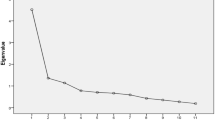Abstract
In this study, a follow-up analysis of the data reported in Lin et al. (Learn Media Technol. doi: 10.1080/17439884.2011.629660, 2011), we investigated the relationship between student use of a virtual field trip (VFT) system and the probability of students reporting wanting to visit the national park site upon which the VFT was modeled, controlling for content knowledge and prior visits to the park. Students who were able to navigate the VFT in teams were more likely than their peers who had the system demonstrated by a teacher to want to visit the national park. In addition, students with higher pre-intervention content knowledge were more likely to want to visit the national park than their peers with lower pre-test scores, in both the teacher demonstration and student co-navigation conditions.








Similar content being viewed by others
References
Bransford JD, Schwartz DL (1999) Rethinking transfer: a simple proposal with multiple implications. Rev Educ Res 24:61–100
Chang CY, Hsiao CH, Barufaldi J (2006) Preferred-actual learning environment 'spaces' and earth science outcomes in Taiwan. Sci Educ 90(3):420–433
Chang CY, Lin MC, Yang CF, Lin CY (2010) A VR too for assisting geological field trip. J Cyber Ther Rehabil 3(2):190–192
Chien YT, Chang CY (2012) Comparison of different instructional multimedia designs for improving student science-process skill learning. J Sci Educ Technol 23(1):106–113
Chinn CA, Brewer WF (2001) Models of data: a theory of how people evaluate data. Cogn Instr 19:323–393
Deci EL, Ryan RM (1985) Intrinsic motivation and self-determination in human behavior. Plenum, New York
Dede C (2009) Immersive interfaces for engagement and learning. Science 323(5910):66–69
Dieterle E, Clarke J (2007) Multi-user virtual environments for teaching and learning. In: Pagani M (ed) Encyclopedia of multimedia technology and networking, 2nd edn. Idea Group, Inc Press, Hershey
Falk J, Martin W, Balling J (1978) The novel field trip phenomenon: adjustment to novel settings interferes with task learning. J Res Sci Teach 15(2):127–134
Garner LC, Gallo MA (2005). Field trips and their effect on student achievement and attitudes: a comparison of physical versus virtual field trips to the Indian river lagoon. J College Sci Teach 34(5)
Harrington MCR (2009). An Ethnographic comparison of real and virtual reality field trips to trillium trail: the salamander find as a salient event. In: Freier NG, Kahn PH (eds) Child youth environ 19(1)
Harrington MCR (2011a) Empirical evidence of priming, transfer, reinforcement, and learning in the real and virtual trillium trails. IEEE Trans Learn Technol 2(2):175–186
Harrington MCR (2011b) The virtual trillium trail and the empirical effects of freedom and fidelity on discovery-based learning. Virtual Real. doi:10.1007/s10055-011-0189-7
Ketelhut DJ (2007) The impact of student self-efficacy on scientific inquiry skills: an exploratory investigation in river city, a multi-user virtual environment. J Sci Educ Technol 16(1):99–111
Ketelhut DJ, Nelson BC, Clarke JE, Dede C (2010) A multi-user virtual environment for building and assessing higher order inquiry skills in science. Br J Educ Technol 41(1):56–68
Krajcik JS, Blumenfield P (2006) Project-based learning. In: Sawyer RK (ed) The cambridge handbook of the learning sciences. Cambridge, New York
Lee MS, Chang CY, Tsai CC (2009) Exploring Taiwanese high school students’ perceptions of and preferences for teacher authority in the earth science classroom with relation to their attitudes and achievement. Int J Sci Educ 31(13):1811–1830
Lin MC, Tutwiler MS, Chang CY (2011) Exploring the relationship between virtual learning environment preference, use, and the learning outcomes in 10th grade earth science students. Learn Media Technol 36(4):399–417
National Research Council (2005) How students learn: history, mathematics, and science in the classroom. National Academies Press, Washington, DC
Nelson BC (2007) Exploring the use of individualized, reflective guidance in an educational multi-user virtual environment. J Sci Educ Technol 16(1):83–97
Nelson BC, Erlandson BE (2008) Managing cognitive load in educational multi-user virtual environments: reflection on design practice. Educ Tech Res 56(5–6):619–641
Ritter M E (1998) Virtual field trips: Just like being there. Teach technol today 2, 2–3. Retrieved May 23, 2012 from http://www.wisconsin.edu/ttt/tttv2n4.htm
Ryan RL, Deci EL (2000) Self-determination theory and the facilitation of intrinsic motivation, social development, and well-being. American Psychologist 55(1):68–78. doi:10.1037/0003-066X.55.1.68
Veletsianos G, Heller R, Overmyer S, Procter M (2010) Conversational agents in virtual worlds: bridging disciplines. Br J Educ Technol 41(1):123–140
White B, Frederiksen J (1998) Inquiry, modeling, and metacognition: making science accessible to all students. Cogn Instr 16(1):3–118
Acknowledgments
The authors wish to thank our anonymous reviewers and the Aim for the Top University (ATU) project of the National Taiwan Normal University (NTNU) funded by Ministry of Education and the National Science Council (NSC) of Taiwan under contracts NSC 100-2631-S-003-006 for financing this study.
Author information
Authors and Affiliations
Corresponding author
Appendix
Appendix
See Table 4.
Pre and Post Test Instrument (translated from the original Chinese)

Pre-intervention survey (translated from the original Chinese)

Post-Intervention Survey (translated from the original Chinese)

Rights and permissions
About this article
Cite this article
Tutwiler, M.S., Lin, MC. & Chang, CY. Determining Virtual Environment “Fit”: The Relationship Between Navigation Style in a Virtual Field Trip, Student Self-Reported Desire to Visit the Field Trip Site in the Real World, and the Purposes of Science Education. J Sci Educ Technol 22, 351–361 (2013). https://doi.org/10.1007/s10956-012-9398-4
Published:
Issue Date:
DOI: https://doi.org/10.1007/s10956-012-9398-4




